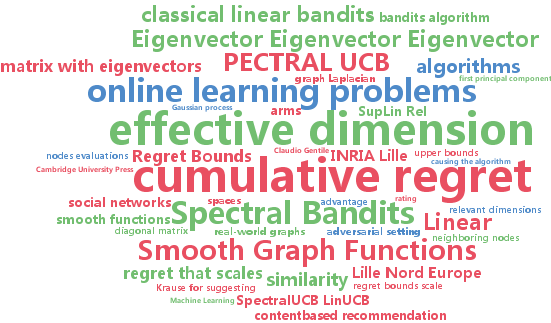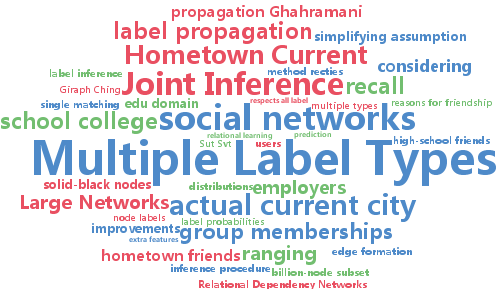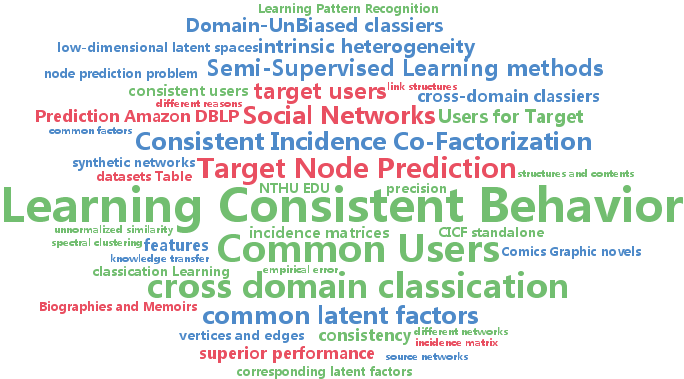social networks
-
Michal Valko and Remi Munos and Branislav Kveton and Tomáš Kocák
Spectral Bandits for Smooth Graph Functions (pdf)
Smooth functions on graphs have wide applications in manifold and semi-supervised learning. In this paper, we study a bandit problem where the payoffs of arms are smooth on a graph. This framework is suitable for solving online learning problems that involve graphs, such as content-based recommendation. In this problem, each item we can recommend is a node and its expected rating is similar to its neighbors. The goal is to recommend items that have high expected ratings. We aim for the algorithms where the cumulative regret with respect to the optimal policy would not scale poorly with the number of nodes. In particular, we introduce the notion of an effective dimension, which is small in real-world graphs, and propose two algorithms for solving our problem that scale linearly and sublinearly in this dimension. Our experiments on real-world content recommendation problem show that a good estimator of user preferences for thousands of items can be learned from just tens of nodes evaluations.
-
Deepayan Chakrabarti and Stanislav Funiak and Jonathan Chang and Sofus Macskassy
Joint Inference of Multiple Label Types in Large Networks (pdf)
We tackle the problem of inferring node labels in a partially labeled graph where each node in the graph has multiple label types and each label type has a large number of possible labels. Our primary example, and the focus of this paper, is the joint inference of label types such as hometown, current city, and employers, for users connected by a social network. Standard label propagation fails to consider the properties of the label types and the interactions between them. Our proposed method, called EdgeExplain, explicitly models these, while still enabling scalable inference under a distributed message-passing architecture. On a billion-node subset of the Facebook social network, EdgeExplain significantly outperforms label propagation for several label types, with lifts of up to 120% for recall@1 and 60% for recall@3.
-
Claudio Gentile and Shuai Li and Giovanni Zappella
Online Clustering of Bandits (pdf)
We introduce a novel algorithmic approach to content recommendation based on adaptive clustering of exploration-exploitation (``bandit") strategies. We provide a sharp regret analysis of this algorithm in a standard stochastic noise setting, demonstrate its scalability properties, and prove its effectiveness on a number of artificial and real-world datasets. Our experiments show a significant increase in prediction performance over state-of-the-art methods for bandit problems.
-
Shan-Hung Wu and Hao-Heng Chien and Kuan-Hua Lin and Philip Yu
Learning the Consistent Behavior of Common Users for Target Node Prediction across Social Networks (pdf)
We study the target node prediction problem: given two social networks, identify those nodes/users from one network (called the source network) who are likely to join another (called the target network, with nodes called target nodes). Although this problem can be solved using existing techniques in the field of cross domain classification, we observe that in many real-world situations the cross-domain classifiers perform sub-optimally due to the heterogeneity between source and target networks that prevents the knowledge from being transferred. In this paper, we propose learning the consistent behavior of common users to help the knowledge transfer. We first present the Consistent Incidence Co-Factorization (CICF) for identifying the consistent users, i.e., common users that behave consistently across networks. Then we introduce the Domain-UnBiased (DUB) classifiers that transfer knowledge only through those consistent users. Extensive experiments are conducted and the results show that our proposal copes with heterogeneity and improves prediction accuracy.



